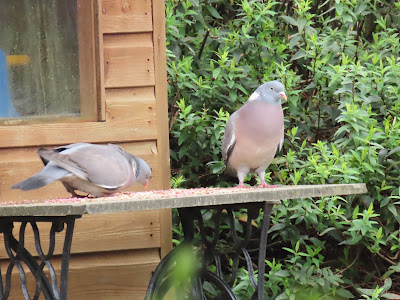With the Big Garden Birdwatch this weekend, I made sure my garden feeders were filled with sunflower hearts, peanuts and seed, and put out fat balls and a suet block, then after scattering a mixture of bird food and scraps on the top of the bird table ( an old sewing machine table) and on the paving below, I sat by the window and waited...
It was only a matter of seconds before the first visitors arrived; two smart male blackbirds, which went straight for the bird table. A minute or so later, a magpie flew into the top of next door's walnut tree which gave it a vantage point over my garden, then flew off again. Meanwhile the feeding station was visited by a dunnock, a blue tit and a robin, whilst a wood pigeon perched on top of the willow.
Ten minutes into the birdwatch, a single longtailed tit arrived, had a peck at the suet block and went again. I waited for some more of this species to join it as they usually go around in flocks but none appeared. The crow and magpie reappeared which frightened off the other smaller birds. After grabbing a piece of bread the magpie flew off, as did the crow.
As the minutes passed the bird feeders were visited regularly by various smaller birds, including a couple of goldfinches and house sparrows. Four starlings also flew down and feasted on the pink berry suet pellets and two wood pigeons fed from the table.
By the end of the hour, I had seen 32 birds of 11 species:
blackbird 4, robin 2, dunnock 2, magpie 2, wood pigeon 6, blue tit 3, great tit 2, house sparrow 3, crow 2, goldfinch 2, starling 4. (No sparrow hawk!)
(P.S. I did the bird watch with groups of pupils at school today; from memory we counted:
blackbird 5; robin 2; blue tit 4; great tit 1; wren 1; long tailed tit 2; dunnock 2; collared dove 2; wood pigeon 2; jackdaw 7; house sparrow 25 ( mostly bathing in the pond); song thrush (singing from a tree continually during our birdwatch) 1; chaffinch 2; 13 species 56 birds.
Significantly higher than in my own garden; the school's wildlife garden backs onto fields and hedgerows in the Cotswolds.)
Once I had reached the end of my hour's bird watch, I packed the car ready to make another visit to Slimbridge WWT centre. I don't usually visit the centre three weekends in succession, but with nothing else planned, and a few species currently there that I hadn't yet seen this year, I decided to go, even though it was pretty overcast. I had also been given instructions to locate a particular tree favoured by a tawny owl for roosting during the day time, so decided to include a visit during the day too.
Arriving at 10.15, the car park was not particularly busy, no doubt the dull weather had put off some of the family visitors, but there were still a good number of birders around the reserve, with many of the hides having several occupants. I made straight for the Zeiss hide, towards the far end of the reserve, where a green winged teal had been reported recently. I couldn't find it amongst the birds I could make out through my binoculars, but was kindly shown it through another birder's telescope, the vertical white stripe on its side just showing amongst some sleeping teal, which distinguished it from the usual teal with the horizontal stripe. (This is the second rarity I have seen this week, the first being an Eastern Lesser Whitethoat in the Cotswold Water parks, which although much closer, has been impossible to photograph due to its preference for remaining in the undergrowth!)
Continuing to the Kingfisher hide, I located a large goose flock, comprising barnacle, greylags and white fronted geese, and a small group of pink footed geese which have been on the reserve for most of the winter. Again I benefited from another birder's 'scope' to see them clearly.
At the opposite end of the reserve, I walked along the estuary walkway, visiting the willow hide, where I had a quick view of a resident water rail, which had been joined in its channel by five teal. Here the feeders were busy with the usual garden visitors; tits, house sparrows and chaffinches and three squirrels too.
From the new estuary tower, there were good views of a large number of curlew, and wigeon as well as greylag and Canada geese. Bewick swans were feeding in the flooded fields. After eating my lunch in the heated Peng observatory I returned to my car to make the short journey over to Frampton to see if I could spot the Tawny Owl. However, disappointingly it was not roosting in its usual place today, but now I know where to look, I will try and re-visit next time I visit slimbridge.
lapwing
Bewick swans
teal ( not green winged)
the channel where the water rail 'lives'
view from Estuary tower
glimpse of water rail























































.JPG)
